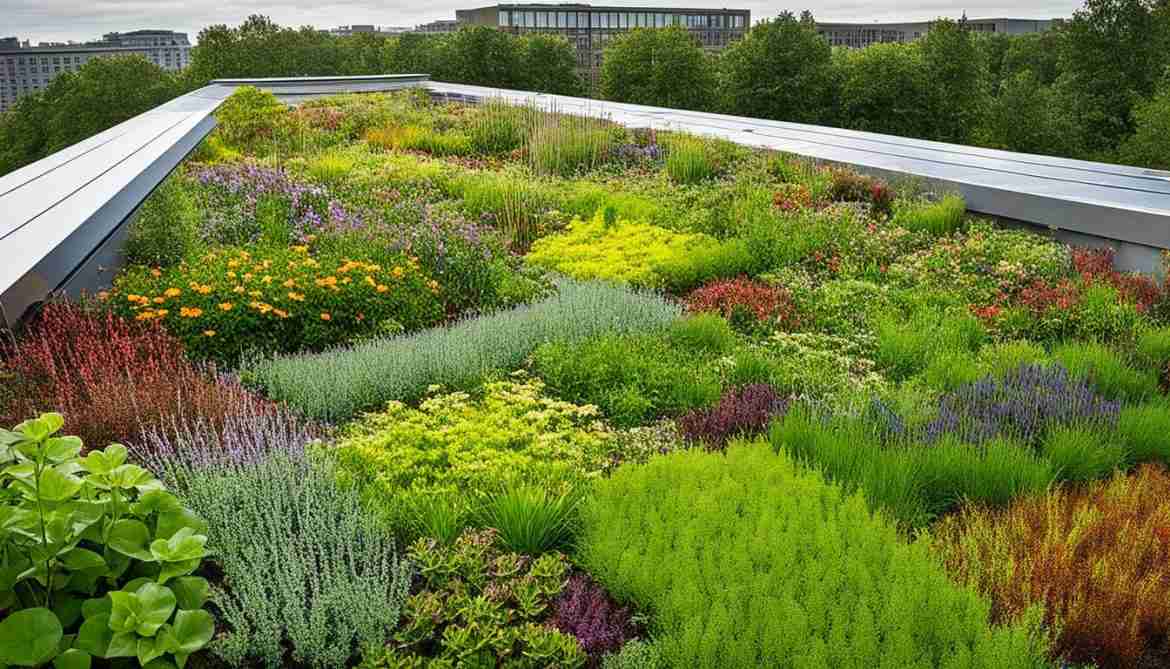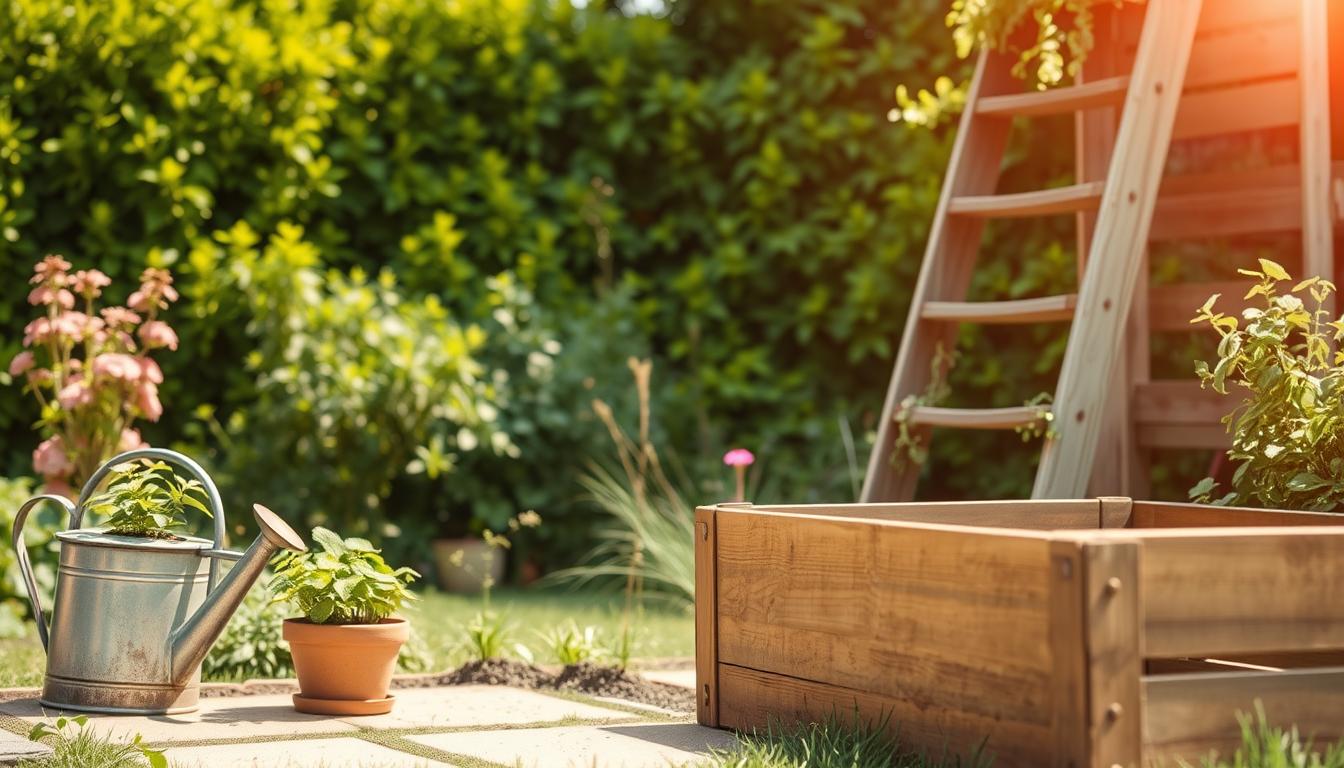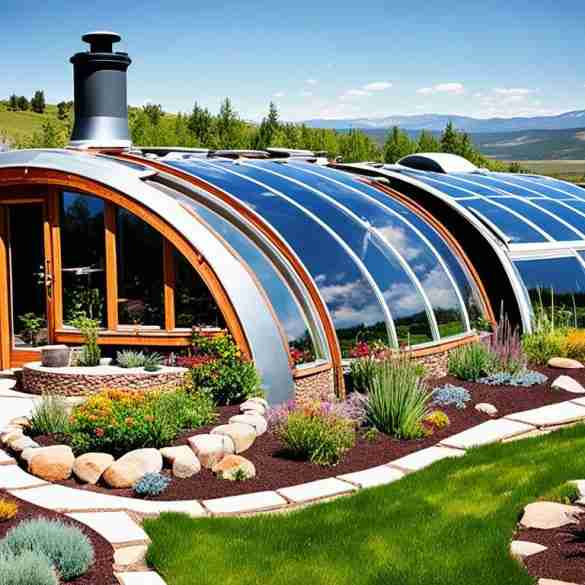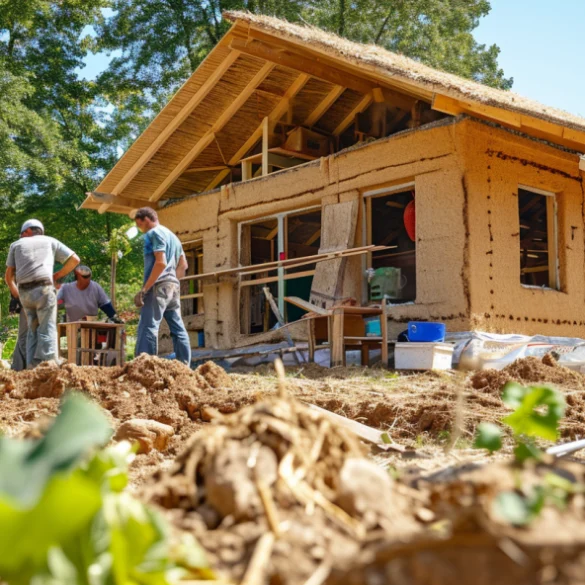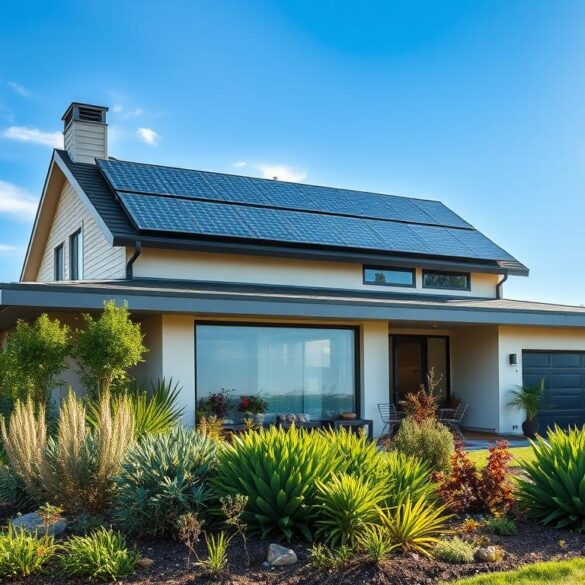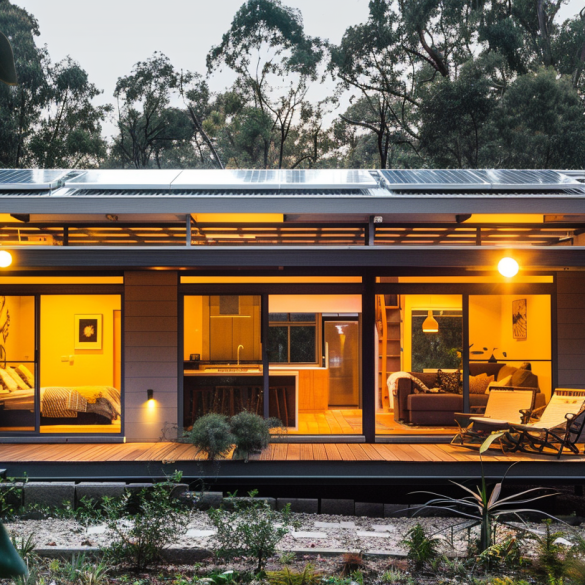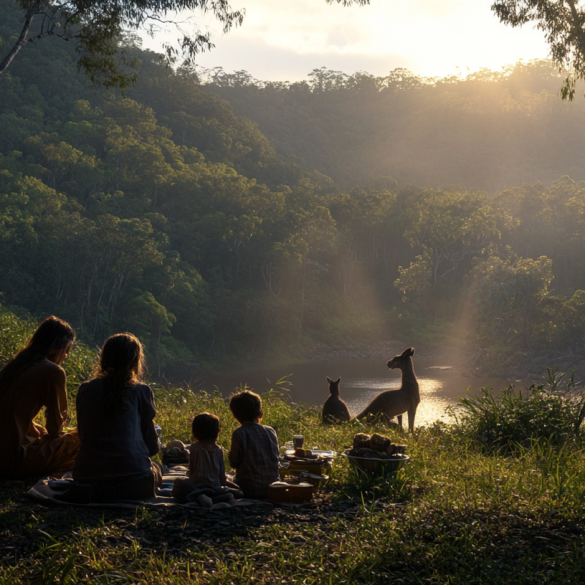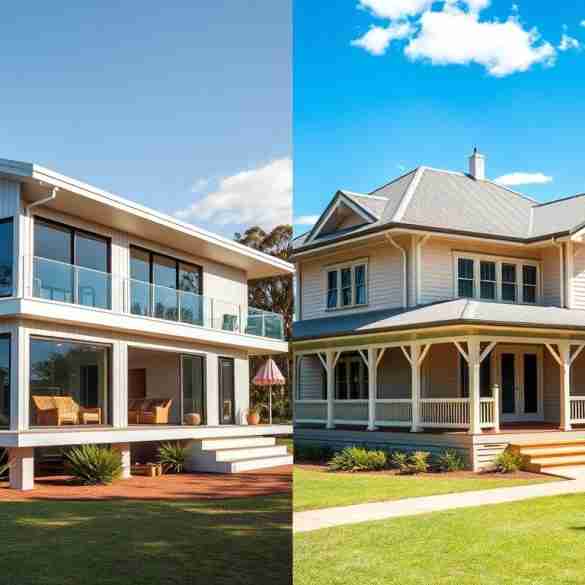Welcome to Sustainable Home Magazine! This article will explore the world of eco-friendly green roof design solutions. Green roofs offer homeowners sustainable and environmentally friendly options, allowing them to enhance the sustainability of their homes while enjoying a range of environmental benefits.
Green roofs are a roofing system that incorporates vegetation, providing an innovative and eco-friendly alternative to traditional roofs. These designs not only add beauty and aesthetic appeal to a home but also contribute to a greener and more sustainable future.
By implementing green roofs, homeowners can make a positive impact on their surroundings. These roofs help manage rainwater and stormwater effectively, contribute to energy efficiency, mitigate the urban heat island effect, and promote biodiversity in urban settings.
Table of Contents
Key Takeaways:
- Green roof design offers sustainable and eco-friendly solutions for homeowners.
- Green roofs provide various benefits for the environment, such as improved rainwater management and energy efficiency.
- Different types of green roofs exist, including cool roofs, metal roofs, and solar roofs.
- Green roof installation and maintenance require specialized techniques and materials.
- Choosing the right plants and accessories is crucial for green roof success.
Types of Green Roofs
Green roofs offer a diverse range of options to suit different preferences and needs. Let’s explore some of the types of green roofs available:
Cool Roof
A cool roof is designed to reflect sunlight away from the building, reducing heat absorption and keeping the interior cooler. These roofs are typically made of light-colored materials that reflect more sunlight, helping to reduce the urban heat island effect in hot climates.
Green Roof
A green roof, also known as a living roof, is a roof covered with vegetation and plants. This type of roof provides numerous benefits, including improved air quality, thermal insulation, and stormwater management. Green roofs also create a natural habitat for birds and insects, promoting biodiversity in urban areas.
Metal Roof
Metal roofs have gained popularity as a sustainable roofing option due to their durability and longevity. They are resistant to fire, insects, and rot, making them an environmentally friendly choice. Metal roofs can also be designed to reflect sunlight and improve energy efficiency.
Reclaimed Clay Roof
Reclaimed clay roofs offer a unique and eco-friendly option for homeowners. These roofs are made from salvaged clay tiles that have been repurposed, reducing waste and environmental impact. Reclaimed clay roofs provide a classic and timeless aesthetic while promoting sustainability.
Slate Tile Roof
Slate tile roofs are known for their natural beauty and durability. These roofs are made from natural slate stone, which is a sustainable and long-lasting roofing material. Slate tile roofs are highly resistant to fire, wind, and water, making them an excellent choice for environmentally conscious homeowners.
Solar Roof
Solar roofs combine the benefits of green roofs with renewable energy generation. These roofs feature solar panels integrated into the roof structure, harnessing the power of the sun to generate electricity. Solar roofs not only provide energy for the home but also contribute to reducing carbon emissions and promoting sustainability.
Each type of green roof offers its advantages and characteristics. Choosing the right green roof for your home depends on factors such as climate, budget, and personal preferences. Consider consulting a professional roofing contractor to determine the best green roof option for your specific needs.
Benefits of Green Roofs
Green roofs offer a wide range of benefits that make them a sustainable roofing solution for homeowners. Let’s explore some of the key advantages:
Improved Rainwater and Stormwater Management
One of the significant benefits of green roofs is their ability to manage rainwater and stormwater effectively. The vegetation and substrate layers of green roofs act as natural filters, absorbing and retaining rainwater, thereby reducing the pressure on stormwater infrastructure and minimizing the risk of flooding in urban areas.
Enhanced Sustainability
Green roofs contribute to the overall sustainability of buildings and cities. By reducing energy consumption and greenhouse gas emissions, green roofs support eco-friendly living. Furthermore, they provide insulation, reducing the need for heating and cooling systems, which leads to energy savings and lower utility bills.
Eco-friendliness
With their abundance of natural vegetation, green roofs create mini-ecosystems that promote biodiversity and improve air quality. These eco-friendly roofs act as carbon sinks, absorbing pollutants and filtering out harmful substances from the air. Additionally, they help counteract the heat island effect in urban areas, preventing excessive heat buildup and creating a more pleasant and livable environment.
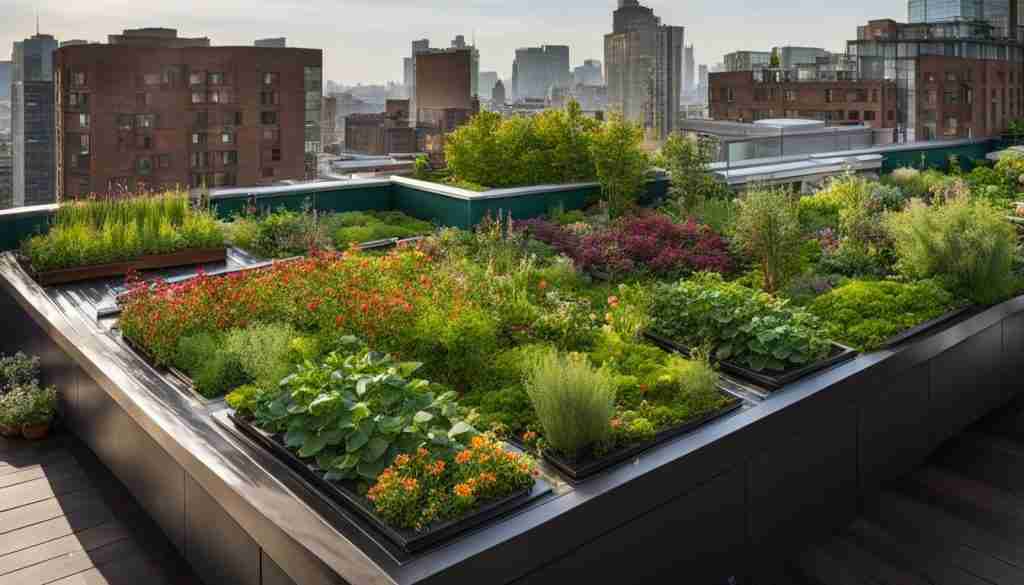
| Benefits | Description |
|---|---|
| Improved rainwater and stormwater management | The vegetation and substrate layers of green roofs help absorb and retain rainwater, reducing the risk of flooding and pressure on stormwater infrastructure. |
| Enhanced sustainability | Green roofs contribute to energy savings, reduced greenhouse gas emissions, and lower utility bills by providing insulation and reducing the need for heating and cooling systems. |
| Eco-friendliness | Green roofs create mini-ecosystems, promoting biodiversity, improving air quality, and mitigating the urban heat island effect in cities. |
By embracing green roofs, homeowners can enjoy these benefits while making a positive impact on the environment and creating a healthier and more sustainable future.
Green Roof Installation and Maintenance
Installing a green roof involves the careful process of adding a layer of vegetation to your roof. This installation process requires expertise in specialized techniques and materials to ensure the successful growth and sustainability of the green roof. When it comes to maintaining a green roof, regular care is essential to ensure its health and longevity. This maintenance includes tasks such as watering, fertilizing, and trimming the vegetation to promote healthy growth.
In addition to regular upkeep, it’s important to address any potential issues that may arise, such as leaks or drainage problems. Regular inspections will help identify any maintenance needs and ensure that your green roof continues to provide the full range of benefits it offers.
The cost of installing and maintaining a green roof can vary depending on several factors. These factors include the size of your roof, the type of vegetation you choose, and the specific requirements of your location. While green roof installation and maintenance may incur some upfront costs, they can lead to long-term savings by reducing energy consumption, extending your roof’s lifespan, and minimizing the need for costly repairs and replacements.
If you’re considering a green roof for your home, it’s important to consult with professionals who specialize in green roof installation and maintenance to ensure the best results. They can provide insights into the specific requirements of your home and help you make informed decisions about the most suitable vegetation and maintenance plan for your green roof.
Green Roof Materials
When it comes to constructing a green roof, the choice of materials plays a crucial role in ensuring its longevity and functionality. Green roofs can be built using a combination of different materials, each serving a specific purpose in creating a sustainable and thriving rooftop ecosystem.
1. Sedum Vegetation
One of the most popular green roof materials is sedum vegetation. Sedums are low-maintenance, drought-tolerant plants that thrive in various climates and provide excellent ground cover. Their shallow roots make them ideal for green roofs as they require minimal soil depth.
2. Soil
Soil is another essential component of green roof construction. It acts as a growing medium for plants, providing them with the necessary nutrients and support for their growth. The soil used in green roofs is lightweight and specifically engineered to minimize the overall weight of the roof structure.
3. Drainage Layers
Drainage layers play a crucial role in preventing water accumulation on green roofs. These layers, typically made of lightweight aggregate or geotextile fabric, allow excess water to drain away effectively, preventing waterlogged soil and potential damage to the roof structure.
4. Waterproof Membranes
Waterproof membranes are vital for protecting the roof structure from moisture penetration. These membranes, typically made of rubber or synthetic materials, create a barrier between the roof and the growing medium, ensuring that water does not seep into the underlying layers.
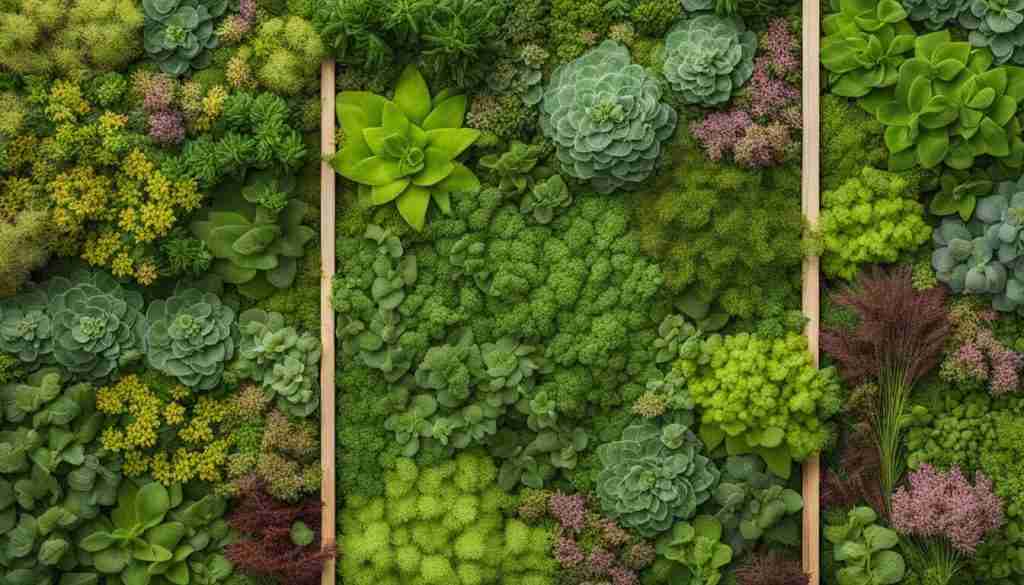
| Material | Benefits |
|---|---|
| Sedum Vegetation | – Low maintenance |
| Soil | – Supports plant growth |
| Drainage Layers | – Prevents water accumulation |
| Waterproof Membranes | – Protects roof structure from moisture |
By combining these materials in a well-constructed layered system, green roofs can provide proper insulation, effective drainage, and a healthy environment for plants to thrive. The choice of materials depends on various factors, such as the local climate, roof structure, and desired aesthetic appeal.
Green Roof Technologies
Green roof technologies play a crucial role in creating sustainable and eco-friendly roofs. These innovative design and construction methods not only enhance the aesthetic appeal of buildings but also contribute significantly to environmental conservation. By integrating with green building design principles and promoting the concept of green infrastructure, these technologies offer a holistic approach to sustainable development.
One prominent example of green roof technology is the implementation of living roofs, also known as rooftop gardens. These green spaces not only provide a visually appealing environment but also offer numerous benefits for urban areas. Living roofs promote the integration of nature in urban spaces, creating a peaceful and biodiverse atmosphere within the concrete jungle.
By utilizing green roof technology, buildings can contribute to the overall well-being of their occupants and the environment. The use of vegetation on roofs helps reduce the urban heat island effect by providing additional insulation, mitigating heat absorption, and improving air quality. Moreover, green roof technology supports rainwater management efforts by reducing stormwater runoff and enhancing water absorption.
Incorporating Green Roof Technology into Green Building Design
Green roof technology aligns seamlessly with green building design, which focuses on creating energy-efficient and sustainable structures. These approaches work together harmoniously to achieve maximum environmental impact and long-term benefits.
By combining the principles of green roof technology and green building design, architects and developers can create buildings that are not only aesthetically pleasing but also environmentally responsible. Green roofs act as an extension of green infrastructure, contributing to the overall health and sustainability of the surrounding ecosystem.
With the integration of green roof technology, buildings can serve as living examples of sustainable design, showcasing the importance of incorporating nature into urban areas. These eco-friendly structures offer a multitude of benefits, including improved air quality, reduced energy consumption, and increased biodiversity.
| Benefits of Green Roof Technology in Green Building Design | Examples |
|---|---|
| Improved air quality | Reduced emissions and pollutants in urban areas |
| Reduced energy consumption | Lower cooling and heating costs |
| Biodiversity preservation | Creation of habitats for birds, insects, and other species |
| Stormwater management | Reduction of stormwater runoff and flood risks |
| Enhanced aesthetics | Creation of inviting and visually pleasing urban landscapes |
Green roof technology continues to evolve, offering endless possibilities for sustainable development. As more architects and developers embrace these innovative solutions, the benefits of green roofs and green building design will extend to a larger, more sustainable built environment.
Green Roof Benefits for Energy Efficiency
Green roofs offer significant benefits for energy efficiency, making them an environmentally friendly choice for homeowners. By incorporating a green roof on your building, you can experience a range of advantages that positively impact both your energy consumption and the environment.
Reduced need for heating and cooling systems
One of the key benefits of green roofs is their ability to provide additional insulation for buildings. The layer of vegetation acts as a natural barrier, minimizing heat transfer between the interior and exterior of your home. This insulation helps regulate indoor temperatures, reducing the need for excessive heating or cooling systems. As a result, you can enjoy a more comfortable living space while consuming less energy.
Mitigation of the urban heat island effect
Green roofs play a significant role in mitigating the urban heat island effect, particularly in densely populated areas. The urban heat island effect refers to the phenomenon where urban environments experience higher temperatures due to heat generated by buildings and human activities. By covering rooftops with vegetation, green roofs absorb and dissipate heat, reducing the overall temperature and creating a more pleasant microclimate. This effect not only benefits the building itself but also contributes to a cooler and healthier cityscape.
Energy savings and reduced carbon footprint
When your building has a green roof, it requires less energy for heating and cooling, resulting in significant energy savings. By reducing your reliance on artificial heating and cooling systems, you can lower your utility bills and decrease your carbon footprint. Green roofs are an excellent investment in both energy efficiency and sustainability, allowing you to contribute to a greener future.
Green Roof Plant Selection
When designing a green roof, selecting the right plants is crucial to ensure their survival and optimal performance. Consider the following factors when choosing plants for your green roof:
Adaptability to Local Climate
Green roofs should feature plants that can thrive in the specific climate of your region. Choose plants that are native or well-adapted to the local weather conditions, such as drought-tolerant species for arid climates or moisture-loving plants for humid areas. This will help minimize the need for excessive watering and ensure the plants’ resilience to extreme temperatures.
Ability to Withstand Rooftop Conditions
Roof environments can be challenging, with exposure to strong winds, intense sunlight, and limited soil depth. Select plants that have sturdy root systems and can withstand these rooftop conditions. Drought-resistant plants with deep root structures are ideal, as they can harness water more effectively and anchor themselves securely to the roof substrate.
Maintenance Requirements
Consider the maintenance needs of the chosen plants. Green roofs require regular upkeep, including watering, fertilizing, pruning, and monitoring for pests or diseases. Opt for low-maintenance plants that have minimal pruning requirements and can thrive with limited irrigation. This will help reduce maintenance efforts and costs associated with maintaining your green roof.
Enhance your green roof with accessories that optimize its functionality and performance:
Irrigation Systems
An irrigation system can ensure proper hydration for your green roof plants, especially during dry periods. Drip irrigation or micro-sprinklers can provide targeted watering, minimizing water wastage and promoting healthy plant growth.
Protective Barriers
Protective barriers can prevent soil erosion and mitigate the risk of plant displacement during heavy rains or strong winds. These barriers help retain the growth medium and keep the plants securely rooted, ensuring the longevity of your green roof.
When combined with the appropriate plant selection and accessories, green roofs can thrive and provide a myriad of benefits.
| Plant Name | Adaptability to Climate | Ability to Withstand Rooftop Conditions | Maintenance Requirements |
|---|---|---|---|
| Sedum spectabile ‘Autumn Joy’ | Drought-tolerant; adaptable to various climates | Tolerates rooftop conditions well; withstands wind and intense sunlight | Low maintenance; requires minimal watering and pruning |
| Allium schoenoprasum (Chives) | Adaptable to a wide range of climates | Thrives in rooftop environments; resistant to wind and heat | Low maintenance; occasional watering and pruning |
| Phlox subulata (Moss Phlox) | Adaptable to various climates | Withstands rooftop conditions; heat and drought tolerant | Low maintenance; requires moderate watering and occasional pruning |
Remember, the specific plant selection may vary depending on your location and specific green roof design. Consult with a green roof professional or horticulturist to determine the most suitable plant options for your green roof.
Green Roof Construction and Design
When it comes to green roof construction, careful planning and design are key to creating a sustainable and environmentally friendly roof. Green roof technologies and sustainable roof systems are integrated into the construction and design process to ensure long-term viability and maximize the benefits of green roofs.
Green roof construction involves the intricate process of designing and building a roof that can support vegetation and provide the necessary infrastructure for its growth. This includes selecting appropriate materials, ensuring proper insulation and drainage, and creating a suitable environment for plants to thrive.
To construct a green roof, several factors need to be considered:
- Structural Integrity: The roof must have the structural capacity to bear the additional weight of the green roof system, including soil, plants, and water.
- Waterproofing: A reliable waterproofing system is crucial to prevent water leakage into the building and ensure the longevity of the roof.
- Drainage: Proper drainage systems are necessary to manage excess water and prevent water accumulation that could damage the roof and the building.
- Growing Medium: The selection of the right growing medium, such as lightweight soil or engineered substrates, is vital for providing plants with adequate nutrients and support.
- Plant Selection: Choosing suitable plants that can thrive in the rooftop environment, withstand extreme weather conditions, and contribute to biodiversity is essential.
Green roof design also incorporates sustainable and green building solutions to enhance the overall environmental performance of the roof and the building. These solutions may include:
- Solar Panels: Integrating solar panels into the green roof system allows for renewable energy generation, reducing reliance on traditional energy sources.
- Rainwater Harvesting: Green roofs can be designed to collect and store rainwater for irrigation purposes, reducing the demand for municipal water supply.
- Insulation: Green roofs provide additional insulation, improving energy efficiency and reducing heating and cooling costs.
- Biodiverse Planting: Incorporating a diverse range of plant species in the green roof promotes biodiversity and ecosystem health.
By combining green roof technologies and sustainable roof systems with innovative design techniques, green roofs offer a holistic solution that benefits both the environment and the building occupants. They provide numerous advantages, including improved energy efficiency, reduced stormwater runoff, enhanced air quality, and the creation of urban green spaces.
Environmental Benefits of Green Roofs
Green roofs offer a multitude of environmental benefits that contribute to a healthier and more sustainable urban environment. By incorporating rooftop gardens and green spaces into our cities, we can create a harmonious balance between nature and urban living.
Improved Air Quality
One of the key environmental benefits of green roofs is their ability to improve air quality. The plants and soil on green roofs act as natural filters, removing pollutants and fine particulate matter from the air. This helps to reduce the harmful effects of air pollution and create cleaner, fresher air for all.
Enhanced Biodiversity
Rooftop gardens and green spaces contribute to the preservation and enhancement of biodiversity in urban areas. By providing habitat for birds, insects, and other wildlife, green roofs help to support and maintain diverse ecosystems. This promotes a healthier and more balanced natural environment, even in the midst of a concrete jungle.
Creation of Urban Green Spaces
Green roofs play a crucial role in the creation of urban green spaces. They transform barren rooftops into vibrant and sustainable havens for people and wildlife alike. These green spaces offer a range of benefits, from providing tranquil retreats for city dwellers to offering opportunities for urban agriculture and community gardening.
Rainwater Management
Another significant environmental benefit of green roofs is their contribution to effective rainwater management. The vegetation and substrate on green roofs absorb and retain rainwater, reducing the burden on stormwater systems and mitigating the risk of flooding. This helps to maintain a more sustainable water cycle within cities and reduces the strain on infrastructure.
By harnessing the environmental benefits of green roofs, we can create greener and more resilient cities that prioritize sustainability and the well-being of both humans and the natural world.
| Environmental Benefits of Green Roofs | Description |
|---|---|
| Improved Air Quality | Green roofs act as natural filters, removing pollutants from the air. |
| Enhanced Biodiversity | Rooftop gardens and green spaces support diverse ecosystems, providing habitat for birds and insects. |
| Creation of Urban Green Spaces | Green roofs transform barren rooftops into vibrant havens for people and wildlife. |
| Rainwater Management | Green roofs absorb and retain rainwater, reducing strain on stormwater systems and mitigating flooding. |
Conclusion
The incorporation of sustainable roof design and the implementation of green roofs in urban areas offer a multitude of benefits for both homeowners and the environment. By embracing eco-friendly solutions, we can create livable spaces that positively impact our planet.
Sustainable roof design provides a holistic approach to building construction by integrating eco-friendly materials and practices. By utilizing green roofs, homeowners can reduce energy consumption, enhance rainwater management, and mitigate the urban heat island effect. These roofs act as natural insulators, regulating indoor temperatures and reducing the need for artificial heating and cooling systems. As a result, homeowners can lower their utility bills and minimize their carbon footprint.
In addition to the benefits for homeowners, sustainable roof design also contributes to the well-being of the environment. Green roofs promote biodiversity, create urban green spaces, and improve air quality. They serve as natural habitats for plants, insects, and birds, adding to the overall ecological balance. Furthermore, green roofs aid in stormwater management by reducing the strain on local drainage systems, preventing flooding, and improving water quality.
Overall, embracing sustainable design in the form of green roofs is a vital step towards creating a greener and more sustainable future. By implementing these innovative solutions in urban areas, we can transform our cities into healthier, more resilient spaces that prioritize the well-being of both people and the planet.
FAQ
What are the types of green roofs?
The types of green roofs include cool roofs, green roofs, metal roofs, reclaimed clay roofs, slate tile roofs, and solar roofs. Each type offers unique benefits and characteristics.
What are the benefits of green roofs?
Green roofs provide numerous benefits such as improved rainwater and stormwater management, enhanced sustainability, and eco-friendliness. They also contribute to the overall energy efficiency of buildings and help mitigate the urban heat island effect.
How is a green roof installed and maintained?
Green roof installation involves the process of installing a layer of vegetation on the roof, which requires specialized techniques and materials. Additionally, green roofs require regular maintenance to ensure their health and longevity. The cost of installing and maintaining green roofs can vary depending on factors such as roof size and type of vegetation.
What materials are used in green roof construction?
Green roofs can be constructed using various materials, such as sedum vegetation, soil, drainage layers, and waterproof membranes. The construction techniques for green roofs involve creating a layered system that provides proper insulation and drainage for the plants.
What are green roof technologies?
Green roof technologies encompass the use of innovative design and construction methods to create sustainable and eco-friendly roofs. These technologies often integrate with green building design principles and promote the concept of green infrastructure. Living roofs, or rooftop gardens, are a popular form of green roof technology that promotes the integration of nature in urban spaces.
How do green roofs contribute to energy efficiency?
Green roofs contribute to energy efficiency by providing additional insulation, reducing the need for heating and cooling systems, and mitigating the urban heat island effect. They help regulate indoor temperature and reduce energy consumption, resulting in lower utility bills and a smaller carbon footprint.
What should be considered when selecting plants for green roofs?
When selecting plants for green roofs, it is essential to consider their adaptability to the local climate, their ability to withstand rooftop conditions, and their maintenance requirements. Additionally, green roofs can be enhanced with various accessories, such as irrigation systems and protective barriers.
How are green roofs constructed and designed?
Green roof construction involves the intricate process of designing and building a roof that supports vegetation and provides the necessary infrastructure for its growth. Sustainable roof systems and green building solutions are often integrated into the construction and design of green roofs to ensure their long-term viability and environmental benefits.
What are the environmental benefits of green roofs?
Green roofs offer numerous environmental benefits, including improved air quality, enhanced biodiversity, and the creation of urban green spaces. They also contribute to rainwater management and help reduce the overall impact of buildings on the environment.
What are the benefits of incorporating green roofs into urban design?
By incorporating green roofs into urban design, we can create more sustainable and livable spaces that positively impact our planet. Green roofs provide eco-friendly and sustainable solutions for buildings, offering a range of benefits for homeowners and the environment.
Source Links
- https://www.architecturaldigest.com/reviews/home-improvement/six-eco-friendly-roof-designs
- https://sempergreen-international.com/us/blog/green-roof-systems-a-sustainable-solution-for-urban-environments/
- https://www.culturesouthwest.org.uk/architecture/green-roofing-solutions-that-require-little-maintenance/

